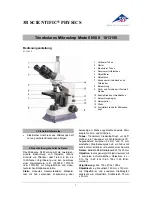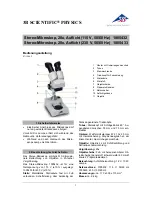
11
Frequently Asked Questions
1) What can I see with my microscope?
You can see thousands of things that are difficult or impossible to see with your eyes. You can see
tiny plants and animals. You can observe plant and animal cells. You can see the differences
between different plants, different papers, different fibers, and hairs from different people. You can
study crystals, rocks, and minerals. The uses for your microscope are practically endless.
2) What is meant by power?
Power is a measure of the seeing ability of your microscope. It is really a short way of saying
“magnifying power.” Your microscope has three powers. They are 300X (pronounced “300 times”),
600X, and 1,200X. This means that your microscope can magnify the view of a sample so that it
appears 300 times, 600 times, or 1,200 times larger than the way you see it with your own eyes.
3) I look through my microscope and all I see is darkness. Why?
This could be because the mirror or light bulb is not positioned properly to aim light up into your
microscope. Or maybe the sample you are looking at is too thick so the light cannot shine through it.
4) All I can see is a partial circle of light. Why?
To see your sample properly, the light source must be centered through the slide to provide the
brightest and most even illumination. Try gently moving the mirror or light until you see a full, evenly lit
circle while looking through the microscope.
5) I have a very thin sample on my slide, but I can’t see any detail.
First, make sure that the image is in sharp focus by adjusting the focusing knobs. If the problem still
exists you should add a drop of red or blue stain to the sample. Stains make hard-to-see objects like
plant cells stand out so they can be seen better.
BATTERY INFORMATION:
This unit uses two AA batteries. Always use fresh batteries. Do not use rechargeable batteries. If the microscope will not
be used for a long time, remove the batteries. Non-rechargeable batteries are not to be recharged. Different types of
batteries or new and used batteries are not to be mixed. Do not take batteries apart. Exhausted batteries are to be
removed from the microscope. The supply terminals should not be short-circuited. Do not dispose of batteries in fire. They
may explode.
!
Made in China
Part #: 260006
WARNING! CHOKING HAZARD –
Small parts. Not suitable for children
under 3 years.





























